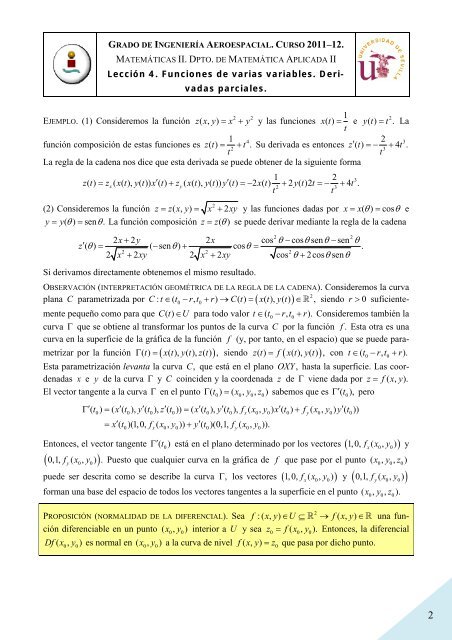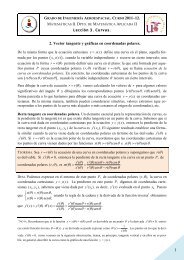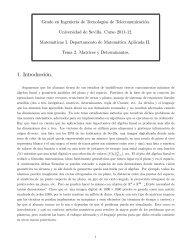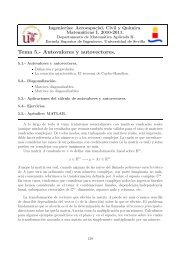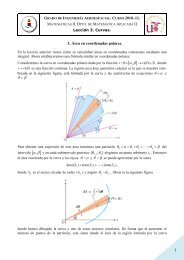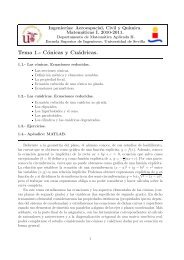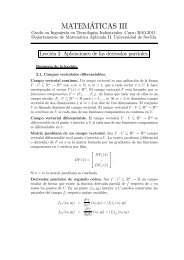Leccion 4. 4. Las reglas de la cadena - Matemática Aplicada II
Leccion 4. 4. Las reglas de la cadena - Matemática Aplicada II
Leccion 4. 4. Las reglas de la cadena - Matemática Aplicada II
Create successful ePaper yourself
Turn your PDF publications into a flip-book with our unique Google optimized e-Paper software.
GRADO DE INGENIERÍA AEROESPACIAL. CURSO 2011–12.<br />
MATEMÁTICAS <strong>II</strong>. DPTO. DE MATEMÁTICA APLICADA <strong>II</strong><br />
Lección <strong>4.</strong> Funciones <strong>de</strong> varias variables. Derivadas<br />
parciales.<br />
2 2<br />
1<br />
2<br />
EJEMPLO. (1) Consi<strong>de</strong>remos <strong>la</strong> función z( x, y) = x + y y <strong>la</strong>s funciones xt () = e y() t = t . La<br />
t<br />
1 4<br />
2 3<br />
función composición <strong>de</strong> estas funciones es zt () = + t.<br />
Su <strong>de</strong>rivada es entonces z′ () t =− + 4 t .<br />
2<br />
3<br />
t<br />
t<br />
La reg<strong>la</strong> <strong>de</strong> <strong>la</strong> ca<strong>de</strong>na nos dice que esta <strong>de</strong>rivada se pue<strong>de</strong> obtener <strong>de</strong> <strong>la</strong> siguiente forma<br />
1 2 3<br />
zt () = zx( xt (), yt ()) x′ () t + zy( xt (), yt ()) y′ () t =− 2 xt () + 2 yt ()2t=− + 4 t.<br />
2 3<br />
t t<br />
2<br />
(2) Consi<strong>de</strong>remos <strong>la</strong> función z = z( x, y) = x + 2xy<br />
y <strong>la</strong>s funciones dadas por x= x( θ ) = cosθ<br />
e<br />
y = y( θ ) = sen θ.<br />
La función composición z = z( θ ) se pue<strong>de</strong> <strong>de</strong>rivar mediante <strong>la</strong> reg<strong>la</strong> <strong>de</strong> <strong>la</strong> ca<strong>de</strong>na<br />
2 2<br />
2x+ 2y 2x cos θ −cosθsenθ −sen<br />
θ<br />
z′<br />
( θ) = ( − sen θ) + cos θ =<br />
.<br />
2 2 2<br />
2 x + 2xy 2 x + 2xy cos θ + 2cosθsenθ Si <strong>de</strong>rivamos directamente obtenemos el mismo resultado.<br />
OBSERVACIÓN (INTERPRETACIÓN GEOMÉTRICA DE LA REGLA DE LA CADENA). Consi<strong>de</strong>remos <strong>la</strong> curva<br />
2<br />
p<strong>la</strong>na C parametrizada por C: t∈( t0 − r, t0 + r) → C( t) = ( x( t), y( t)<br />
) ∈ , siendo r > 0 suficientemente<br />
pequeño como para que Ct ( ) ∈ U para todo valor t∈( t0 − r, t0 + r).<br />
Consi<strong>de</strong>remos también <strong>la</strong><br />
curva Γ que se obtiene al transformar los puntos <strong>de</strong> <strong>la</strong> curva C por <strong>la</strong> función f . Esta otra es una<br />
curva en <strong>la</strong> superficie <strong>de</strong> <strong>la</strong> gráfica <strong>de</strong> <strong>la</strong> función f (y, por tanto, en el espacio) que se pue<strong>de</strong> parametrizar<br />
por <strong>la</strong> función Γ () t = ( x(), t y(), t z() t ) , siendo zt () = f( xt (), yt () ) , con t∈( t0 − r, t0 + r).<br />
Esta parametrización levanta <strong>la</strong> curva C , que está en el p<strong>la</strong>no OXY , hasta <strong>la</strong> superficie. <strong>Las</strong> coor<strong>de</strong>nadas<br />
x e y <strong>de</strong> <strong>la</strong> curva Γ y C coinci<strong>de</strong>n y <strong>la</strong> coor<strong>de</strong>nada z <strong>de</strong> Γ viene dada por z = f( x, y).<br />
El vector tangente a <strong>la</strong> curva Γ en el punto Γ ( t0) = ( x0, y0, z0)<br />
sabemos que es Γ ′ ( t0),<br />
pero<br />
Γ ′ ( t0) = ( x′ ( t0), y′ ( t0), z′ ( t0)) = ( x′ ( t0), y′ ( t0), fx( x0, y0) x′ ( t0) + fy( x0, y0) y′ ( t0))<br />
= x′ ( t )(1,0, f ( x , y )) + y′ ( t )(0,1, f ( x , y )).<br />
Entonces, el vector tangente ′ ( t0)<br />
( y 0 0 )<br />
0 x 0 0 0 y 0 0<br />
Γ está en el p<strong>la</strong>no <strong>de</strong>terminado por los vectores ( 1, 0, ( , ) )<br />
f x y y<br />
0,1, f ( x , y ) . Puesto que cualquier curva en <strong>la</strong> gráfica <strong>de</strong> f que pase por el punto ( x0, y0, z 0)<br />
pue<strong>de</strong> ser <strong>de</strong>scrita como se <strong>de</strong>scribe <strong>la</strong> curva Γ , los vectores ( 1, 0, f x ( x0, y 0)<br />
) y ( 0,1, f y ( x0, y 0)<br />
)<br />
forman una base <strong>de</strong>l espacio <strong>de</strong> todos los vectores tangentes a <strong>la</strong> superficie en el punto ( x0, y0, z 0).<br />
2<br />
PROPOSICIÓN (NORMALIDAD DE LA DIFERENCIAL). Sea f :( x, y) ∈U ⊆ → f( x, y)<br />
∈<br />
una función<br />
diferenciable en un punto ( x0, y 0)<br />
interior a U y sea z0 = f( x0, y0).<br />
Entonces, <strong>la</strong> diferencial<br />
Df ( x0, y 0)<br />
es normal en ( x0, y 0)<br />
a <strong>la</strong> curva <strong>de</strong> nivel f ( xy , ) = z0que<br />
pasa por dicho punto.<br />
x<br />
0 0<br />
2


